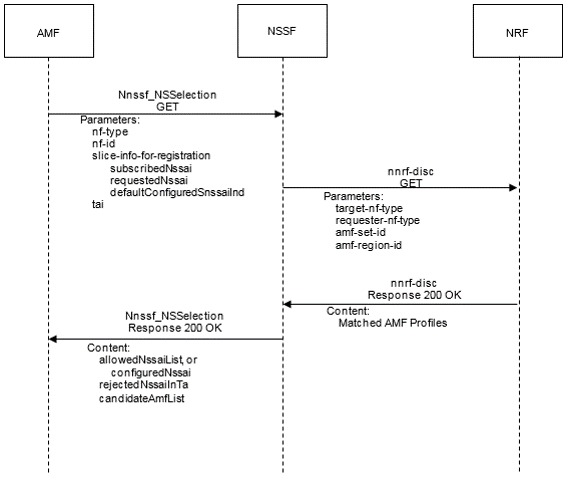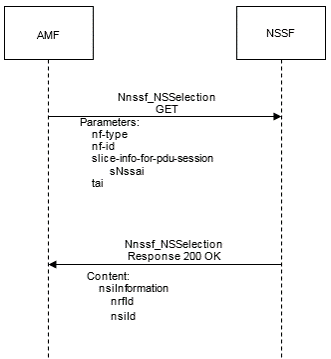Network Slice Selection Service
The Network Slice Selection service is identified by the service operation
name, Nnssf_NSSelection.This service supports GET request during the following
procedures by UE:
- Initial Register: When the NSSF is able to find authorized network slice information for the requested network slice selection information, the response body includes a payload body containing at least the Allowed NSSAI, target AMF Set or the list of candidate AMF(s).
- PDU Session Establishment: When NSSF receives PDU-Session establishment request from NF consumer, NSSF determines network slice which can serve the requested SNSSAI, based on user configured policies, and responds with URL of NRF which manages to the Slice and/or Slice ID of the matching Network Slice computed.
- UE-Config-Update: When the UDM updates the Subscribed S-NSSAI(s) to the serving AMF, based on configuration in this AMF, the NSSF determines the mapping of the Configured NSSAI for the serving PLMN and Allowed NSSAI to the Subscribed S-NSSAI(s).
- Initial Register
Following diagram illustrates the procedure of Initial Register:
Figure 4-1 Initial Register

The following is performed for Initial Register:
- The AMF sends a GET request to the NSSF.
The AMF request must
include:
- Requested NSSAI
- the Mapping of Requested NSSAI to Configured NSSAI for the HPLMN
- the Subscribed S-NSSAIs (with an indication if marked as default S-NSSAI)
- any Allowed NSSAI
The query parameters may also contain:
- mapping to the Configured NSSAI for the HPLMN
- PLMN ID of the Subscription Permanent Identifier (SUPI)
- UE's current Tracking Area
- NF type of the NF service consumer
- AMF id
- Based on this information, local configuration and other locally available
information including RAN capabilities in the current Tracking Area for
the UE, the NSSF does the following:
- It selects the Network Slice instance(s) to serve the UE. When multiple Network Slice instances in the UE's Tracking Areas are able to serve a given S-NSSAI, based on operator's configuration, the NSSF may select one of them to serve the UE, or the NSSF may defer the selection of the Network Slice instance until a NF or service within the Network Slice instance needs to be selected.
- It determines the target AMF set to be used to serve the UE or based on configuration, the list of candidate AMF(s), possibly after querying the NRF.
- It determines the Allowed NSSAI(s) for the applicable Access Type(s), taking also into account the availability of the Network Slice instances that are able to serve the S-NSSAI(s) in the Allowed NSSAI in the current UE's tracking areas.
- Based on operator configuration, the NSSF may determine the NRF(s) to be used to select NFs or services within the selected Network Slice instance(s).
- When the NSSF is able to find authorized network slice information for the requested network, NSSF sends Discovery Request for AMF to NRF.
- The NRF responds with list of candidate AMFs to NSSF.
- The NSSF returns to the current AMF the Allowed NSSAI for the applicable Access Type(s), the target AMF Set, or, based on configuration, the list of candidate AMF(s). The NSSF returns the NRF(s) to be used to select NFs/services within the selected Network Slice instance(s), and the NRF to be used to determine the list of candidate AMF(s) from the AMF Set. The NSSF returns NSI ID(s) to be associated to the Network Slice instance(s) corresponding to certain S-NSSAIs. NSSF also returns the rejected S-NSSAI(s) and the Configured NSSAI for the Serving PLMN.
- The AMF sends a GET request to the NSSF.
The AMF request must
include:
- PDU Session Establishment
The PDU Session Establishment in a Network Slice to a DN allows data transmission in a Network Slice. A PDU Session is associated to an S-NSSAI and a DNN. Following diagram illustrates the procedure of PDU Session Establishment:
Figure 4-2 PDU Session Establishment

The following is performed for PDU Session Establishment:
- If the AMF is not able to determine the appropriate NRF to query for the S-NSSAI provided by the UE, the AMF sends a GET request to the NSSF. The AMF queries the NSSF with this specific S-NSSAI, the NF type of the NF service consumer, Requester ID, PLMN ID of the SUPI and location information.
- The NSSF determines and returns the appropriate NRF to be used to
select NFs/services within the selected Network Slice instance. The NSSF
may also return an NSI ID identifying the Network Slice instance to use
for this S-NSSAI.
When a PDU Session for a given S-NSSAI is established using a specific Network Slice instance, the CN provides to the (R)AN the S-NSSAI corresponding to this Network Slice instance to enable the R(AN) to perform access specific functions.
- UE-Config-Update
When the UDM updates the Subscribed S-NSSAI(s) to the serving AMF, based on configuration in this AMF, the NSSF determines the mapping of the configured NSSAI for the serving PLMN and ALLOWED NSSAI to the Subscribed S-NSSAI(s). Following diagram illustrates the procedure of UE-Config-Update:
Figure 4-3 UE-Config-Update

The following is performed for UE-Config-Update:
- The AMF sends a UE-Config-Update (GET) request to NSSF. NSSF checks and validates the Subscribed S-NSSAI(s), Requested S-NSSAI(s), PLMN ID of the SUPI, TAI, NF type, and NF instance ID. If message is valid, NSSF searches for allowed S-NSSAI list based on policy configuration and input parameters.
- NSSF responds with 200 OK with AuthorizedNetworkSliceInfo in case NSSF finds a match.
- NSSF responds with 200 OK with empty AuthorizedNetworkSliceInfo in case there is no match found.
- NSSF responds with error code in case of incorrect parameter validation.